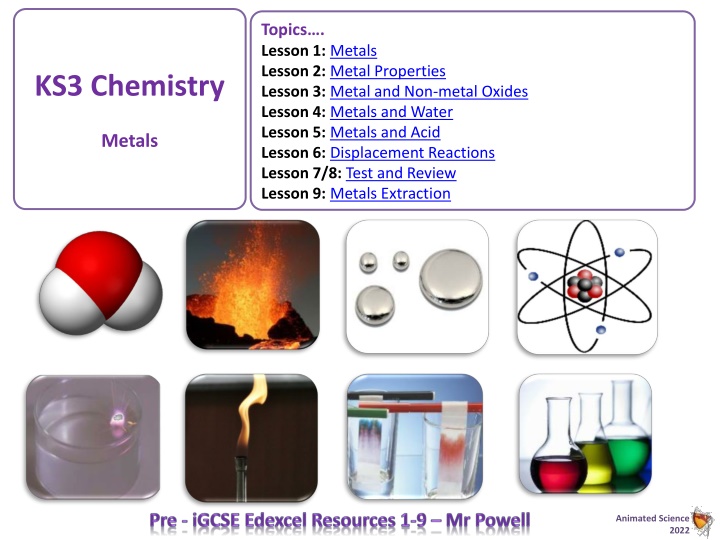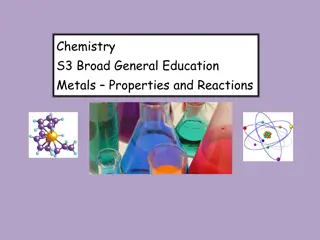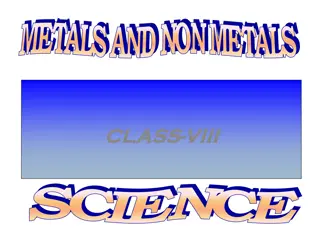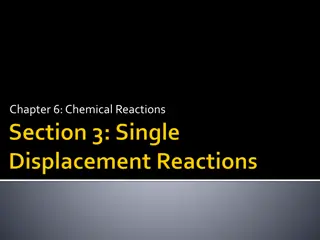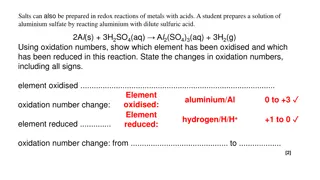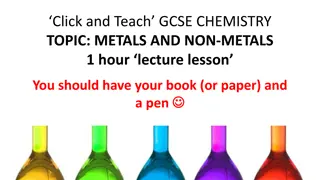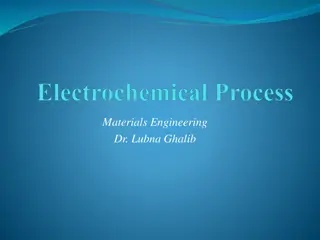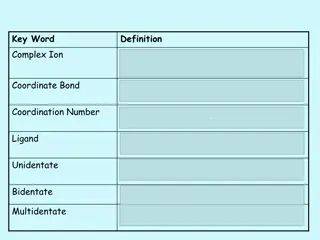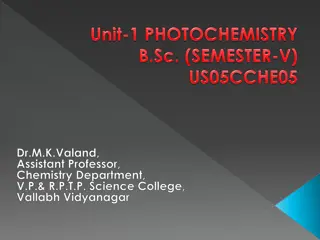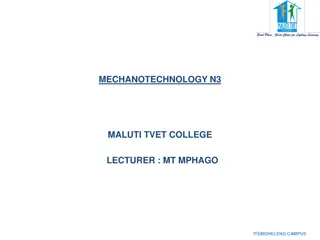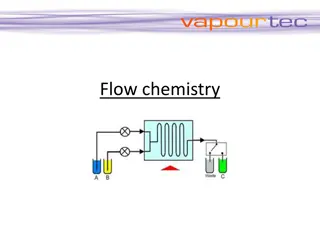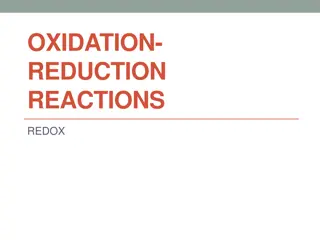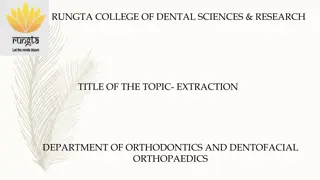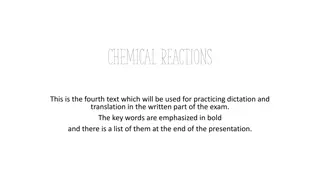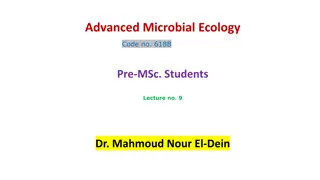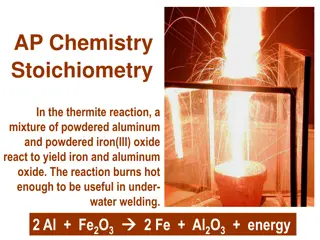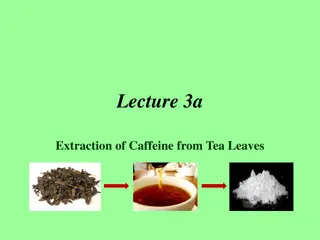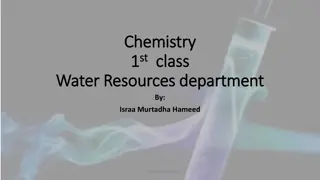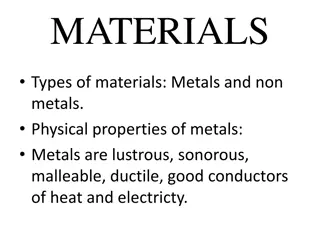Metals: Properties, Reactions & Extraction in Chemistry
Explore the fascinating world of metals through lessons on their properties, reactions with water and acids, displacement reactions, extraction processes, and more. Delve into key terms, such as ions and reactivity series, while discovering how metals interact with various substances. Engage with revision videos demonstrating practical experiments and learn about the deadly element Polonium in a real-life case. Enhance your knowledge of metals with useful information and test your understanding with thought-provoking questions.
Download Presentation

Please find below an Image/Link to download the presentation.
The content on the website is provided AS IS for your information and personal use only. It may not be sold, licensed, or shared on other websites without obtaining consent from the author.If you encounter any issues during the download, it is possible that the publisher has removed the file from their server.
You are allowed to download the files provided on this website for personal or commercial use, subject to the condition that they are used lawfully. All files are the property of their respective owners.
The content on the website is provided AS IS for your information and personal use only. It may not be sold, licensed, or shared on other websites without obtaining consent from the author.
E N D
Presentation Transcript
Topics. Lesson 1: Metals Lesson 2: Metal Properties Lesson 3: Metal and Non-metal Oxides Lesson 4: Metals and Water Lesson 5: Metals and Acid Lesson 6: Displacement Reactions Lesson 7/8: Test and Review Lesson 9: Metals Extraction KS3 Chemistry Metals 1 Forces and Motion 3 Waves 5 Solid Liquids Gases 6 Magnetism 7 Radioactivity 8 Astrophysics Animated Science 2022
Revision Videos Lesson Metals - Title /Link https://youtu.be/Xe-SwR7iRyI - No sound (shows Li2O) 30s 1 https://youtu.be/PCZtnbxtXqE NaCl formation - 3mins 2 https://youtu.be/T0acKc_GD70 - Alloys https://youtu.be/OuFqtxZJRvM Mg and O2 reaction to form MgO using crucible method https://youtu.be/naCFC8oZ_V0 - Simple burning Mg in air to get MgO https://youtu.be/KDaNg7OjMdQ - Sulfur burns in O2 to form SO2 and acid rain 3 https://youtu.be/nWdK1L7GXys - Burning Steel wool (5mins first half) https://youtu.be/V-0wocipCcI - Bottles and Nail to Show Rusting https://youtu.be/q0CAfXV-YdY - Rusting or Corrosion https://youtu.be/hEtjIHNh1Dk - Copper and Oxygen https://youtu.be/-xVgs60LmXg An experiment demonstrating the reaction of sodium, potassium, zinc, aluminium and iron (nail, steel wool and filings) with oxygen (5 mins) https://youtu.be/J-3lLPTuSG0 - Burning Metals in Air https://youtu.be/-p2kpZRWxM8 - Rubidium and Caesium in water (Seriously Fun!) 4 5 https://youtu.be/Na_6j9y9ke8 - Metals and Acids reactivity series 3mins 6 https://youtu.be/5uxsFglz2ig - Thermite Welding of Train Tracks (3mins 48) Animated Science 2022
Metals Useful Information Key Term Definition Ion Atom that has lost or gained an electron Reactivity Series Non- Metal a positively charged ion, i.e. one that would be attracted to the cathode in electrolysis. Property Metal Cation Potassium State at 25 C Sodium Solid usually S/L/G a negatively charged ion, i.e. one that would be attracted to the anode in electrolysis. Anion Reacts with Water Lithium MP High Low When an electron is free to roam inside a metal (or conductor) this carries the electrical current. Barium delocalised Elec or Thermal Conductivity Good Conductors Insulator Strontium Mixture of metal atoms (randomly) that have unique properties to the original metals i.e. stronger, low corrosion Calcium alloy Shiny (if polished) Magnesium Appearance Dull Reactivity series How we can order materials into how they react with water, acids or oxygen. Aluminium MAZIT! Density High Low Carbon MASH Metal + Acid Salt + Hydrogen Strength Hard / Strong Brittle Zinc alloy Mixture of two metals to improve the properties With Acids Chromium Oxidation With bases Oxidation / Rusting When metals react with oxygen and the metal is oxidised so electrons are removed and an oxide is made. Reacts with Acids Iron Malleability / Ductile deflagrating spoon A small long spoon that we put chemicals on to heat and test in a gas. Yes No Cadmium Cobalt Effervesces When a reaction gives off bubbles like Hydrogen gas. Nickel Tin Lead Hydrogen Antimony Bismuth Copper Unreactive Mercury Silver Gold Animated Science Platinum 2022
Element of Death..... (Quick Review) Questions On the 1st of November 2006, ex-Russian spy Alexander Litvinenko met friends for lunch in London. He spent the night being sick. Days later his hair fell out. His liver started to fail. By the end of the month, Litvinenko was dead. Detectives suspected murder. 1. Describe the idea of the term element 2. Where was the polonium detected? 3. How much polonium is required in your body to kill you. Scientists detected polonium in Litvinenko s urine. Polonium is radioactive. Just 0.000 000 000 007 g of it is enough to kill. 4. Suggest a reason why some elements kill and others are good for the body? (5mins) Polonium is a silver-grey solid at room temperature which Marie and Pierre Curie discovered it in 1898. Polonium is an element. Each element is made of its own type of atom, which is unique to that element. You can t split an element into anything simpler. Each element has its own symbol the symbol for polonium is Po. And every element has its own properties. Animated Science 2022
Mr D Powell 2022 Animated Science 2022 Lesson 1: Metals Key Ideas . Metals mostly conduct electricity and have high melting points. I know that metals conduct electricity whilst non-metalsdon t AND some non-metals have low melting points D/E + explain how atoms can gain or lose electrons to become ions, metal = positive (cation), non-metal = negative (anion) C ++ I can explain why graphite is an exception to the rule and is a non-metal that conducts electricity. B +++ I can explain the concept of a delocalised electron Animated Science 2022
Lesson 1: Metals Conductivity Material Task 1: What is an electrical current? Good Some Zero Copper 1) Explain what an electric current is. Nickel Aluminium 2) What happens inside a metal when it conducts. Tin Iron (large nail) Task 2: Formation of Ions Zinc Sulphur 1) Use the diagrams you have been given to explain how Li2O forms. Carbon 2) Explain how NaCl is formed and include a proper equation to explain the electron movement? Plastic (ruler) Card Task 3: Formation of Ions Rubber (tubing) Glass (beaker) 1) Name 5 key properties of graphite. 2) Explain one Physical and one electrical property in detail. Animated Science 2022
Metals and Non-Metals on a slant! Non-metals have a diagonal line which is confusing This version has most of the elements and clearly is a lot larger and the transition metals show up as a much bigger group. Animated Science 2022
What is an Electric Current When the lamp is on, millions of electrons pass through it every second. The electric current through the lamp is due to electrons passing through it. Each electron carries a tiny negative charge. The rate of flow of electrical charge is called the current. The filament of the torch lamp is a fine metal wire. Metals conduct electricity because they contain conduction (or sea of delocalised) electrons. These electrons move about freely inside the metal. They are not confined to a single atom as they would be in an insulator such as plastic. When the torch is switched on, the cell pushes electrons through the filament. Insulators can t conduct electricity because all the electrons are held in atoms. TASK: 1. explain what an electric current is. What happens inside a metal when it conducts. 2. Animated Science 2022
Formation of Ions Ionic Bonding Stealing! Ions can be formed when a metal reacts with a non-metal. Atoms form ions in order to gain an full outer shell i.e. Lithium Oxide to form an ionic bond. Metal atoms lose electrons to get/achieve a full outer shell. Ionic bonds form when the charges between the metal cation and non-metal anion are equal and opposite. This means that 2 x Li+cations will balance with one O 2anions. This makes the formula for lithium oxide Li2O https://youtu.be/Xe-SwR7iRyI - No sound (shows Li2O) https://youtu.be/PCZtnbxtXqE NaCl formation - 3mins Animated Science 2022
Graphite as a Conductor Graphite is black, shiny and opaque. Graphite is insoluble in water. It has a high melting point. It is a good conductor of electricity. Each carbon atom is bonded into its layer with three strong covalent bonds. This leaves each atom with a spare electron, which together form a delocalised 'sea' of electrons loosely bonding the layers together. These delocalised electrons can all move along together. Task Name 5 key properties of graphite. Graphite contains layers of carbon atoms. It is used in pencil leads because the layers easily slide onto the paper, leaving a black mark. It is a component of many lubricants, for example bicycle chain oil. Explain one Physical and one electrical property. Animated Science 2022
Why does solid Iodine Sublime Low Melting Point (Challenge!) Iodine molecules I2have strong bonds between the atoms but weak intermolecular forces. They are called van der Waals forces and rely on transient dipoles. Some electrons move to one side of the molecule creating a +/- dipole. However, when you heat iodine is quickly sublimes and does not have a liquid phase. Sublimation is the endothermic transition of a substance directly from the solid to the gas phase without passing through the intermediate liquid phase. Animated Science 2022
Conductivity of Materials Practical Conductivity Task . Good Material Some Zero Task Write a clear title in your book Copper Write a title and introduction to your practical for how you will investigate the conductivity of materials. Nickel Write an introduction and draw out the circuit you will use to test each material Aluminium Tin Iron Create your own table to test each of the materials and tick or cross Then draw your table (or use the one given) and conduct your investigation with a partner recording your results. (large nail) Zinc Sulphur Carbon Plastic (ruler) Card Write a clear conclusion. Apparatus (for testing) 6V cells Leads Lamp Croc Clips Rubber (tubing) Glass (beaker) Animated Science 2022
Conductivity of Materials Practical Conductivity Task . Good Material Some Zero Task Write a clear title in your book Copper Write a title and introduction to your practical for how you will investigate the conductivity of materials. Nickel Write an introduction and draw out the circuit you will use to test each material Aluminium Tin Iron Create your own table to test each of the materials and tick or cross Then draw your table (or use the one given) and conduct your investigation with a partner recording your results. (large nail) Zinc Sulphur Carbon Plastic (ruler) Card Write a clear conclusion. Apparatus (for testing) 6V cells Leads Lamp Croc Clips Rubber (tubing) Glass (beaker) Animated Science 2022
Mr D Powell 2022 Animated Science 2022 Lesson 2: Metal Properties Key Ideas . Know and explain some key metallic properties I know several basic properties that metals have D/E MgO(s) + describe how metals may be suited to a role and why C H20 ++ I can explain why a reaction with aluminium is limited AND what an alloy is. Mg B +++ I can Animated Science 2022
Element of Beauty..... Questions Platinum is a silvery-white element. It s not poisonous. It s a metal, so it conducts electricity well. Platinum does not react with most other chemicals. It does not react with dilute acids. The symbol for platinum is Pt. 1. Give two properties of platinum that are typical of most metals? 2. Give two properties of platinum that explain why it makes good jewellery? Platinum jewelry is shiny and popular. South Americans probably made the first platinum jewellery including nose rings and pendants around 2000 years ago. 3. Suggest why platinum might be used in the manufacture of hard disks and catalytic converters? Now, computer hard disks store information in layers of platinum and cobalt which is another metal (symbol Co). Platinum in catalytic converters reduces pollution from cars. (5mins) Platinum can form other compounds which have various applications in photography, zinc etchings, indelible ink, plating, mirrors, porcelain coloring Animated Science 2022
Metal Uses Jewellery should be; shiny, hard, malleable and not react with water or air easily. Good choice are; gold, silver, platinum Electrical Wires need to be ductile, a good conductor of electricity, don t react with water or air. So copper or aluminium choices. Copper is a better conductor than aluminium. Saucepans have to be; good conductors of heat, not react with water be malleable, strong. Copper, aluminium or stainless steel are all good choices. Planes are often made from low density, Malleable, strong, nonreactive aluminium. Aluminium does not react with water or air because it forms a protective coating on its surface Animated Science 2022
Examples of Alloys Animated Science 2022
Examples of Alloys Animated Science 2022
Making Magnesium hydroxide A very clean magnesium ribbon has a mild reaction with cold water, given below. H20 Mg Mg(s) + H2O(g) Mg(OH)2(s) + H2(g) After several minutes, hydrogen gas bubbles form on its surface, and the coil of magnesium ribbon usually floats to the surface. However, the reaction is short-lived because the magnesium hydroxide formed is almost insoluble in water and MgO forms a barrier on the magnesium preventing further reaction. H2(g) Mg(OH)2(s) H20 As a general rule, if a metal reacts with cold water, a metal hydroxide is produced. Mg If it reacts with steam, the metal oxide is formed. Animated Science 2022
Common Examples of Alloys An alloy is a uniform mixture. It is made up of two or more chemical elements of which at least one is a metal. An alloy has properties different from the metals it is made of it may be tougher, more resistant to corrosion or lighter. Most alloys are made by melting the metals, mixing them while they are liquid to form a solution, then leaving them to cool and turn solid again. Duralumin (aluminium, copper, magnesium and manganese) Some alloys have the original metal atoms substituted but some may have them added interstitial to the structure OR it can be a mixture of both ideas. Stainless steel (iron, carbon and chromium), steel (iron and carbon) Bronze (copper and tin), brass (copper and zinc) Task.. Draw your own diagram to show how the metals combine, make a note to explain the ideas. Pewter (tin, copper and antimony) Animated Science 2022
Lesson 2: Metal Properties. Alloys 1) a) What is the alloy of zinc and copper called? b) What is the difference between steel and stainless steel? c) Organise the information provided into a table with three columns. MP of solder oC % of tin An alloy is a uniform mixture. It is made up of two or more chemical elements of which at least one is a metal. An alloy has properties different from the metals it is made of. Most alloys are made by melting the metals, mixing them while they are liquid to form a solution, then leaving them to cool and turn solid again. 25 270 45 225 65 180 85 205 2) Solder is an alloy of tin and lead only.The melting point of solder depends on the percentages of tin and lead mixed together Carbon present in steel alloy% 0.1 0.2 0.3 0.4 0.5 0.6 a) What percentages of tin and lead are present in the solder with the lowest melting point? Solder is also used in electronic circuit boards apart from its low melting point, what other property of solder makes it suitable for use in electronic circuit boards? There are some common alloys: Hardness/ Units b) Brass is made of 35% zinc and 65% copper and is used for musical instruments, jewellery , taps and decorative hardware. 123 157 190 220 260 3) The Falkirk Wheel is made of steel which is an alloy Stainless steel is made of 18% chromium , 80.6% iron , 1% nickel and 0.4% carbon and is used for tableware , cookware and surgical tools. a. b. What is meant by the term alloy? The table gives information on the hardness of some steel alloys. Predict the hardness of the steel alloy containing 0.6% carbon. Steel is made of 99% iron and 1% carbon and is used for tools, car bodies, machinery, girders and rails . Steel is used in buildings. 4) Titanium can be mixed with other metals to make a substance that is strong and lightweight. Medical instruments can be made from a mixture of metals containing 76% titanium, 4% zirconium and the rest is other metals. Label your pie chart with this information Bronze is made of 87.5% copper and 12.5% tin and is used for boat hardware, screws and grill work. 5) Make an informative poster A4 on Alloys and their uses. Include ideas from the internet and images if possible. Solder is a mixture of lead and tin used to join other metals together. Animated Science 2022
Mr D Powell 2022 Animated Science 2022 Lesson 3: Metal and Non-metal Oxides Key Ideas . How do we form oxides and what do they do? I know that metals and non- metals react with oxygen to make oxides D/E + describe that metals make alkaline oxides and non-metals make acidic oxides and give examples C ++ I can explain in detailenvironmental problems associated with some oxides acid rain and rusting B +++ I can explain how acid rain and sulfuric acid is formed in a two stage reaction Animated Science 2022
Mini Review Test Answers 1) Al K C Ca Na Li 1) Write the symbol for . (6 marks) a) Aluminium b) Potassium c) Carbon d) Calcium e) Sodium f) Lithium 2) Which of these are metallic properties (4 marks) a) Shiny b) Brittle c) Insulator d) Conductor of heat and electricity e) Malleable f) Dull g) Solid at room temperature 2) a, d, e, g 3 Sodium Fluoride Copper Sulphide Lithium Nitrate 4) Copper, Sulphur, Oxygen, Hydrogen 3) Name the following compounds: NaF CuS LiNO3 SA Total: 17 4) Name the elements in CuSO4.5H2O Animated Science 2022
Making Magnesium Oxide Pupil Experiment Example Method 1) Glasses on, hair and tie back, blazer off. 2) Setup a Bunsen burner and mat and connect to the gas supply. Ensure the airhole is closed. 3) Have a beaker of water or a watch glass ready next to your Bunsen burner. 4) Heat the magnesium ribbon until it starts to ignite LOOK AWAY to prevent it burning your retina. 5) Take the white oxidised powder and stir into the water or watch glass to check pH 6) Add a few drop of UI and check the pH against a scale. Conclusion Decide what colour the dissolved MgO is on the periodic table? Review the chemical equations below and check they are balanced 2Mg + O2 2MgO MgO + H2O Mg(OH)2 MgO + H2O Mg2+ + 2OH- Animated Science 2022
Metals or Non-Metals & Oxygen Task 1. 2. Watch the video Copy the table into your book Discuss how these reactions may effect the rain? Many metals and non-metals react with oxygen in the air when they are heated to produce metal oxides and non-metal oxides. Steel wool burns brightly to form Fe2O3 3. We place some sulfur on a deflagrating spoon and heat. Then we put the sulfur into a glass jar with oxygen gas to react and form sulfur dioxide gas. If we add water to the jar we can form sulfuric acid (acid rain) and test for acidity. S(s) + O2(g) https://youtu.be/K DaNg7OjMdQ SO2(g) Element Type Reaction type Oxide Nature Highly exothermic - magnesium burns with bright white flame Magnesium oxide, MgO - solid white powder Magnesium Metal Basic exothermic - carbon glows orange when heated strongly Carbon dioxide, CO2- colourless gas with no odour Carbon Non-metal Acidic Sulfur dioxide, SO2- colourless gas with choking smell Sulfur Non-metal Burns slowly with a blue flame Acidic Animated Science 2022
https://youtu.be/OuFqtxZJRvM Making Magnesium Oxide iGCSE Extension Method 1) Find the mass of a crucible 5) Add water to dissolve the MgO and freeing Nitrogen (if it has reacted to form ammonia NH3) to get pure MgO 2) Find the mass of a crucible + Mg ribbon 6) Heat until you have dried the pure white MgO and H2O has evaporated 3) Heat the ribbon 7) Allow to cool in the crucible FLASH DANGER 8) Weigh your new product taking into account the original readings 4) Lift the lid to allow O2 to mix and react Animated Science 2022
Acid Rain - Sulfur dioxide and carbon monoxide Carbon monoxide, CO, is produced when fuels burn in a limited amount of air. It is a colourless, odourless and tasteless gas. Carbon monoxide passes into the red blood cells after breathing it in. It binds more strongly to haemoglobin than oxygen does, so the blood will be able to carry less oxygen than it should. This can cause tiredness, unconsciousness and even death. Fossil fuels naturally contain sulfur compounds. These produce sulfur dioxide, a gas with a sharp, choking smell, when the fuel is burned. When sulfur dioxide dissolves in water droplets in clouds, it makes the rain more acidic than normal. This is called acid rain. Acid rain damages the waxy layer on the leaves of trees. This makes it more difficult for trees to absorb the minerals they need for healthy growth and they may die. Acid rain also makes rivers and lakes too acidic for some aquatic life to survive. Lichens can be used as biological indicators of sulfur dioxide pollution. They grow in exposed places such as rocks or tree bark, which means they easily absorb water and nutrients to grow there. Rainwater contains just enough nutrients to keep them alive. Air pollutants dissolved in rainwater, especially sulfur dioxide, can damage lichens and prevent them from growing. This makes lichens natural indicators of air pollution. For example: bushy lichens need really clean air leafy lichens can survive a small amount of air pollution crusty lichens can survive in more polluted air In places where no lichens are growing it is often a sign that the air is heavily polluted with sulfur dioxide. Trees and limestone buildings are also damaged by acid rain. Task Read the article discuss with a partner the key issues surrounding acid rain Animated Science 2022
Greenhouse Effect (Review) CFC s Carbon Dioxide Methane Nitrous Oxide Haloalkanes Some gases in the Earth's atmosphere absorb infrared radiation. These gases are called greenhouse gases and they keep our planet warm. Carbon dioxide is a greenhouse gas. Even though it is only 0.04% of the atmosphere, carbon dioxide is the key. Refrigerators / Aircon Cattle Oil Gasoline Aerosols Fertiliser Coal Agriculture Other greenhouse gases are water vapour, and also methane. Even though methane is only present in tiny amounts, it is a very efficient absorber of infrared. The greenhouse effect is a natural process that keeps the Earth s atmosphere warm. This has been essential to the evolution of life as we know it. Since the Industrial Revolution, humans have been releasing greenhouse gases into the atmosphere faster than natural processes can remove them. For example, burningfossil fuels releases carbon dioxide. The extra carbon dioxide increases the greenhouse effect, which makes the planet warmer than it would be naturally. The increase in global temperature this causes is called global warming. Global warming is beginning to trigger big changes in the environment. The average temperature of the atmosphere and oceans is increasing slightly every decade, and this is already causing polar ice caps to melt and sea levels to rise. 1. The Sun s rays enter the Earth s atmosphere. 2. Energy is absorbed by the Earth s surface and re-emitted at longer wavelengths, such as infrared radiation (heat). 3. Some emitted heat passes through the atmosphere into space. Task Read the article on global warming and highlight any key ideas 4. Some heat is absorbed by carbon dioxide, a greenhouse gas. Heat is re- emitted in all directions and some becomes trapped within the Earth s atmosphere. The Earth becomes hotter as a result.
Rusting - Oxidation Ironis a good example of rusting or oxidation. The metal will slowly break down by a simple reaction on the surface which then eventually breaks away to leave fresh iron and process starts again. https://youtu.be/q0CAfXV-YdY Iron + oxygen + water Hydrated Iron (III) Oxide We can also stop this process by removing any of the reactants from the situation. When we say that the iron is oxidised we mean electrons are removed to make a +3 ion. (Removal of electrons) (addition of electrons) Task Make your own notes on the idea of rusting as a chemical concept. Animated Science 2022
Rusting Demonstration 4 jars were setup with iron nails so they could rust We then waited for 3 days to see the results Then we shook the jars to see how that would change the outcomes. Which one is rusts more and why? Why did the boiled water make no difference? https://youtu.be/V-0wocipCcI 3mins Animated Science 2022
Mr D Powell 2022 Animated Science 2022 Lesson 4: Metals and Water Key Ideas . What happens when you mix a metal and water from Group 1 I know that different metals have different reactivity in group 1 D/E + describe how metals react with water to make metal hydroxide solutions and hydrogen C ++ I can explain how some metals will react with steam B +++ I can write some equations to explain the reactions of metals and water Animated Science 2022
Reactivity of Metals Task.. Explain this idea and write down the equations (check that they they balance) Reactivity Series Potassium The reactivity series will need to be learned for GCSE. Group 1 metals feature in this series. Each metal has a similar reaction with water. Sodium Reacts with Water Lithium Barium Strontium Calcium Magnesium Aluminium The metal reacts with water to form hydroxides which are soluble in water or alkaline in nature. We can test for the presence using litmus paper or indicator solution. The reaction is also exothermic and gives off heat. Carbon Zinc Chromium Reacts with Acids Iron Cadmium Cobalt Nickel Tin Lead Li, Na, K - https://youtu.be/Tzl4kGneIp Y Hydrogen Antimony Bismuth They also emit hydrogen gas which is flammable. Copper Rb, Cs - https://youtu.be/- p2kpZRWxM8 Unreactive Mercury Silver Gold Group 1 Metal + Water Metallic Hydroxide + Hydrogen 2Na (s) + 2H2O (l) 2NaOH (aq) + H2 (g) Platinum Animated Science 2022
Group 1 Metals The pattern for group 1 metals is simple and the reasoning is that there is one electron in the outer shell which is easily lost to another atom. As you get further down the periodic table the atoms get larger (Francium) and the electron is less tightly held (or shielded from the charge in the nucleus). Hence it reacts more easily. Tasks: 2Na (s) + 2H2O (l) 2NaOH (aq) + H2 (g) Make a note of use for each metal shown in the table. Metal Use Increasing Reactivity Lithium batteries Sodium part of table salt Can you comment on why the reactivity changes? Potassium found in nerve cells melts at 400C / thin film battery Rubidium Can you predict and balance a reaction of Rb with water liquid at room temp/ trigger for a bomb Caesium Francium radioactive Animated Science 2022
Elements of Life..... Tasks: Potassium is vital to life. It keeps your heart, kidneys and nerves working. A shortage of potassium makes people weak, confused and depressed, and can even cause heart attacks. Discuss with a partner why Potassium is important in our bodies? No one eats pure potassium the element catches fire when it touches water. Instead, we eat compounds that contain potassium. Eating too much ordinary table salt (sodium chloride) is harmful to health. So some people eat salt substitutes , which are a mixture of potassium chloride and sodium chloride. Foods like raisins, peanuts and bananas are rich in potassium compounds. Animated Science 2022
Mr D Powell 2022 Animated Science 2022 Lesson 5: Metals and Acids Key Ideas . MASH & MAZIT? I know what MASH stands for! D/E + complete a practical which shows a reactivity series for metal + acid (MAZIT) C ++ I can explain what products are produced and the pattern B +++ I can write word and symbol equations for reaction of metals with acids. Animated Science 2022
Exam Review Question /3 Answers 1. Copper is a metal. At room temperature copper is a strong solid. Give two other properties of copper that show it is a metal. (2) 1) it conducts electricity or heat 2. When copper metal is heated it reacts with a gas in air ductile/ malleable high melting/ boiling point it is shiny / sonorous it forms basic oxides 2) What is the chemical name of the product formed when copper reacts with a gas in air? (1) CuO Copper Oxide Animated Science 2022
MASH ?? Task 1. Write out and explain both check they are balanced. Make a note of what MASH means and how it works. Explain how the acid changes the salt MASH is a really easy way to remember how acids and metals react. 2. 3. They all have the same generic reactants and products Metal Acid Salt name Magnesium chloride Magnesium nitrate Magnesium sulfate Metal + Acid Salt + Hydrogen Hydrochloric acid Magnesium magnesium + sulfuric acid magnesium sulfate + hydrogen Magnesium Nitric acid Magnesium Sulfuric acid Mg(s) + H SO (aq) MgSO (aq) + H (g) Hydrochloric acid Nitric acid Sulfuric acid Hydrochloric acid Nitric acid Sulfuric acid Zinc Zinc chloride Iron + sulfuric acid iron sulfate + hydrogen Zinc Zinc Zinc nitrate Zinc sulfate Iron Iron chloride Fe(s) + H SO (aq) FeSO (aq) + H (g) Iron Iron Iron nitrate Animated Science Iron sulfate 2022
Practical.... A student has a hypothesis..... I think that different metals will react more or less strongly with hydrochloric acid You have been given the following equipment and need to design an experiment to test this out... Make sure you clearly show the following in your work.... 1. 2. 3. 4. Title/Hypothesis (copied) Equipment List Diagram (use a ruler) Method of steps to make a fair test Results Table with obs Analysis (what you conclude) 1. A test tube and test tube rack. 2. Measuring cylinder 3. Some samples of metal: Iron (Fe) Zinc (Zn) Magnesium (Mg) Lead (Pb) 5. 6. Extra Help/ Hints.. If you get stuck ask to see the extra sheets for a quick look Hydrochloric Acid 16 cm3 (dilute) Wooden Split & bunsen (need to light it) 4. 5. Animated Science 2022
Extra Help... Diagram: Reacting Acids with Metals... I think that the different metals will react more or less strongly with hydrochloric acid Method 1. I will setup ....... Effervescen ce Metal Iron (Fe) Analysis Zinc (Zn) I think that ........ Magnesium (Mg) Copper (Cu) Animated Science 2022
Extra Special Help... Reacting Acids with Metals... I think that the different metals will react more or less strongly with hydrochloric acid Method 1. I will setup a small sample of each metal in turn with the 4cm3 of acid. I will place my finger over the end of the tube to collect any gas and observe the fizzing reactions When the fizzing slows down I will light a split and pop the gas. 2. Metal Effervescence 3. Iron (Fe) Zinc (Zn) Analysis Magnesium (Mg) . Lead (Pb) Animated Science 2022
Extra Special Help... Reacting Acids with Metals... I think that the different metals will react more or less strongly with hydrochloric acid Method 1. I will setup a small sample of each metal in turn with the 4cm3 of acid. I will place my finger over the end of the tube to collect any gas and observe the fizzing reactions. When the fizzing slows down I will light a splint and pop the gas. 2. Metal Effervescence 3. 3rd Iron (Fe) 2nd Zinc (Zn) Analysis Magnesium (Mg) 1st Most I think that the gas given off (hydrogen) shows which is the most reactive metal which in this case is clearly magnesium as there was the most .. 4th Least Lead (Pb) Animated Science 2022
Review Questions Metals and Acids Reactivity Series Potassium Sodium 1. How can you make his experiment a fair test? Reacts with Water Lithium Barium Strontium Calcium 2. Give one sign showing that chemical reactions are going on? Magnesium Aluminium Carbon 3. What is the reactivity order, starting with the most vigorous? Zinc Chromium Reacts with Acids Iron Cadmium 4. What is the gas given off and how do you test of it? Cobalt Nickel Tin Lead Answers 1. Use the same amount of acid in each test tube, use pieces of metal that are the same mass or size (or any other sensible suggestions). 2. The acid and metal mixture effervesces or exothermic 3. Magnesium, zinc, iron, lead. (MAZIT) 4. Hydrogen, squeaky pop test, with a lit splint. Hydrogen Antimony Bismuth Copper Unreactive Mercury Silver Gold Platinum Animated Science 2022
MAZIT Reactivity Series Potassium MAZIT is a really easy and simple way to remember some of the reactivity series. Sodium Reacts with Water Lithium Barium Strontium Start with M Magnesium as most reactive down to T Tin the Least. M Calcium Magnesium Aluminium A Carbon Zinc Chromium Reacts with Acids Iron Z Cadmium Cobalt Nickel I Tin Lead Hydrogen T Antimony Bismuth Copper Unreactive Mercury Silver Gold Task Make a note of this idea MAZIT Platinum Animated Science 2022
Metals and Acids Review 3 mins Reactivity Series Potassium Task Sodium Reacts with Water Lithium Barium Watch this expanded group of metals and see how this compares to your sheet. Strontium M Calcium Magnesium Aluminium A Carbon https://youtu.be/Na_6j9y9ke8 Zinc Chromium Reacts with Acids Iron Z Cadmium Cobalt Nickel I Tin Lead Hydrogen T Antimony Bismuth Copper Unreactive Mercury Silver Gold Platinum Animated Science 2022
MAZINTL??? Reactivity Series Potassium Task Sodium Reacts with Water Lithium Barium If you are now happy with MAZIT then why not try out . Strontium Calcium MAZINTL! Magnesium Aluminium Carbon Police Sergeant Charlie Zinc Chromium Reacts with Acids Iron Cadmium Cobalt Nickel MAZINTL Tin Lead Hydrogen Antimony Caught Me Stealing Gold Plate Bismuth Copper Unreactive Mercury Silver Gold Platinum Animated Science 2022
Mr D Powell 2022 Animated Science 2022 Lesson 6: Displacement Reactions Key Ideas . How do these reactions work and how is it linked to the reactivity series? I know the reactivity series D/E + I can use the reactivity series to predict whether a reaction will occur. C ++ I can explain several example reactions and give evidence for why they occur and how they are useful. B +++ I can write displacement word equations which are balanced Animated Science 2022
What is a displacement reaction? A displacement involves a metal and the compound of a differentmetal. A more reactive metal will displace or push out a less reactive metal from its compound in a displacement reaction. The least reactive metal is left on its own after the reaction. It is no longer chemically bonded to any other elements. It is now a pure element. So anything higher on the series i.e. Lithium will be able to split up any lower elements which are in a compound. The image shows an example for how magnesium can displace copper which then falls out of solution as a precipitate. We can see the change of colour in the solution as a 2 evidence for the change in this case but there may be no visible change. nd piece of Animated Science 2022
What is a displacement reaction? Magnesium is more reactive than copper. When a piece of magnesium is dipped into blue copper sulfate solution, a displacement reaction occurs. This is the word equation: magnesium + copper sulfate copper + magnesium sulfate This is the symbol equation: Mg(s) + CuSO (aq) Cu(s) + MgSO (aq) This reaction cannot happen in reverse. Copper cannot displace magnesium from a compound because copper is less reactive than magnesium. Animated Science 2022
Mg(s) + CuSO(aq) Cu(s) + MgSO(aq) Mg(s) + CuSO (aq) Cu(s) + MgSO (aq) Animated Science 2022
https://youtu.be/5uxsFglz2ig - Thermite Welding of Train Tracks (3mins 48) Thermite Reaction The blast furnace is used to produce iron on a large scale. Sometimes, it is necessary to produce a small amount of iron more quickly, for example if railway workers need to produce molten metal to fix a broken rail. The thermite reaction uses aluminium powder and iron(III) oxide. When ignited, the mixture reacts vigorously because of the large difference in reactivity between aluminium and iron. The heat produced in the reaction melts the iron produced. iron(III) oxide + aluminium iron + aluminium oxide Fe2O3(s) + 2Al(s) 2Fe(l) + Al2O3(s) In this reaction, iron oxide loses oxygen to form iron so the iron(III) oxide is reduced. The Aluminium is more reactive that Iron and so steals the oxygen. Task Write a short note of how this works Animated Science 2022
